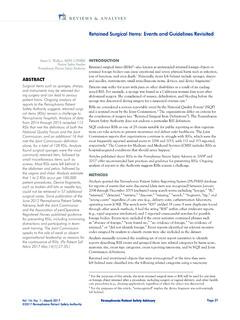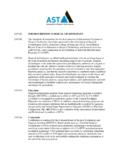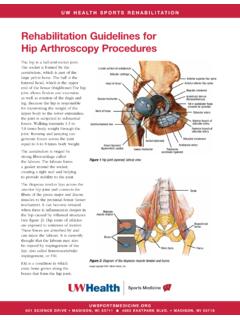Transcription of Guidelines for Surgical Procedures
1 Animal Care and Use Program University of California, Berkeley Guidelines FOR Surgical Procedures . _____. Table of Contents 1) Background 2) Classification of Surgical Procedures 3) Multiple Survival Surgeries 4) Training 5) surgery and Monitoring a) Patient Preparation b) Surgeon Preparation c) Instrument Preparation d) Surgical Technique e) Species-Specific Considerations f) Intraoperative Monitoring g) Immediate Post-operative Care h) Subsequent Post-operative Care 6) References _____. 1. Background In accordance with the Guide for the Care and Use of Laboratory Animals (Guide). and the US Department of Agriculture (USDA) Animal Welfare Act and Regulations (AWA/AWR), all survival Surgical Procedures on vertebrate animals must be performed using aseptic Procedures ( , use of sterile instruments) to prevent postoperative infections.
2 All surgeries and associated details ( , anesthesia, pre- and post-operative care, and recordkeeping) must be described in the Animal Use Protocol (AUP) and approved by the Animal Care and Use Committee (ACUC). These Guidelines outline the general training and techniques required to perform surgeries at UC Berkeley. 2. Classification of Surgical Procedures Surgical Procedures are classified as major or minor; and, survival or non-survival (terminal). Minor surgery does not expose a body cavity and causes little or no physical impairment. Examples include suturing superficial wounds, superficial cut- down for vascular cannulation, or subcutaneous implants.
3 Major surgery penetrates and exposes a body cavity ( , calvarium, abdomen, thorax) or includes Procedures with the potential for significant impairment ( , orthopedic surgeries, stroke models, brain cannulation). Survival surgery is one from which animals are expected to recover. Animal Care and Use Committee Page 1 of 7 Last revised 9/25/2019. Animal Care and Use Program University of California, Berkeley Non-survival or terminal surgeries are Procedures where the animals are euthanized prior to anesthetic recovery as described in the AUP. This includes terminal vascular perfusion. Asepsis and/or sterility are required for all survival surgeries and those non-survival surgeries that exceed 6 hours in duration.
4 Facilities used for survival surgery or non-survival surgery lasting longer than 6 hours must be designed and maintained in such a way that they help prevent the development of intra- and post-procedural infections. Design features include: Separation of the preparation and surgery areas Location that minimize personnel traffic through the surgery area Room surfaces should be non-porous and easily sanitized Rooms are usually positively pressured relative to surrounding areas surgery rooms should be cleaned and disinfected on regular schedules, daily after surgery for work surfaces, weekly to monthly cleaning for floors, walls and cabinets The surgery area should be free of all equipment and materials not necessary for the procedure.
5 Any stored items should be in cabinets or drawers. 3. Multiple Survival Surgeries The use of multiple survival surgeries, either major or minor, must be described and scientifically justified in the PI's AUP and approved by the ACUC. surgery details (anesthesia, pre-, intra- and post-operative monitoring, etc.), the amount of recovery time between surgeries, the number and type of survival surgeries that a single animal may go through, and a reason for why the surgeries cannot be accomplished during one anesthetic episode must be included in the description. Animals transferred between research protocols that have undergone major survival surgery cannot go through an additional major survival surgery unless an exception is granted by the ACUC.
6 4. Training All personnel who perform anesthesia and surgery must be appropriately trained. The Principal Investigator (PI) is responsible for assuring that research personnel receive appropriate training and certification prior to performing any procedure. New surgeons are trained and supervised by the PI, or appropriate designated personnel, until they are competent to perform the procedure independently. All new surgeons, including PIs, must be observed by OLAC veterinary staff and their competency certified to the ACUC prior to working independently. The Office of Laboratory Animal Care (OLAC) veterinary staff is available to provide assistance with, or training in, aseptic technique and the proper administration of anesthesia, analgesia, and euthanasia.
7 A surgery and aseptic techniques class is offered by OLAC each semester (please contact OLAC at 642-9232 for details). Animal Care and Use Committee Page 2 of 7 Last revised 9/25/2019. Animal Care and Use Program University of California, Berkeley 5. surgery and Monitoring a) Patient Preparation i) Survival and Prolonged (> 6 hours) Non-survival surgery (1) While it is common in larger species to withhold food prior to surgery to prevent the possibility of aspiration pneumonia after regurgitation, this practice is not necessary in rodents or rabbits. Water should never be withheld. (2) All animals must be weighed prior to surgery . Pre- Surgical weights must be recorded on the blue postsurgical cage card and/or full Surgical record as applicable (3) In most cases, sterile ophthalmic ointment should be applied to each eye to prevent corneal damage.
8 (4) Hair or feathers must be removed (via shaving, depilatory agent, etc.) from the Surgical site. This step should be performed in a location separate from where the surgery is to be conducted ( a separate lab bench). (5) The skin is scrubbed with Surgical disinfectants, such as dilute chlorhexidine or betadine scrub. Scrubbing starts at the center of the Surgical site and radiates outward with disinfectants subsequently wiped off with alcohol or sterile water. Repeat at least three times or until site is free of visible debris. Note: (a) Surgical scrubbing of the skin is recommended for scaled vertebrates but not for fish and amphibians, as it removes the protective slime layer.
9 (b) Alcohol by itself is not an appropriate skin disinfectant for surgery . (c) Do not over wet the animal as rodents are especially subject to hypothermia. (6) Sterile Surgical drapes are appropriate for most surgeries. Drapes should be secured so as to remain in place over the animal, yet allow for monitoring of the anesthetic depth of the animal. Sterile paper, cloth, or clear plastic adhesive drapes may be used. (7) Ancillary heat (circulating warm water or warm air blanket, infrared warming pad, chemical warming pads, thermal gel packs) should be provided for most species undergoing Procedures lasting longer than 5. minutes. Over the counter electric heating pads and heat lamps are not to be used as they can overheat the patient and lead to skin burns.
10 Always have a towel or drape between the heat source and the animal ii) Non-survival surgery (< 6 hours). (1) Non-survival surgeries not performed aseptically or in a dedicated facility must at least be performed in a clean area, free of clutter. Personnel present in the area must observe reasonable cleanliness practices for both themselves and the animals. (2) No expired drugs or fluids are allowed. Pharmaceutical-grade agents Animal Care and Use Committee Page 3 of 7 Last revised 9/25/2019. Animal Care and Use Program University of California, Berkeley (USP) must be used unless an exemption is approved by the ACUC. b) Surgeon Preparation i) Survival and Prolonged (> 6 hours) Non-survival surgery (1) For non-rodent mammal major survival surgeries, hands are thoroughly scrubbed with an antiseptic Surgical soap and sterile Surgical gloves are to be worn for all survival surgeries.







